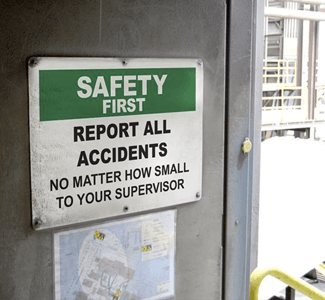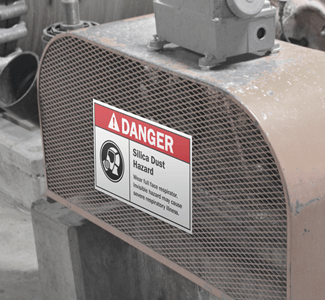Next Steps to Safety: 5 OSHA Rule Changes for 2023

As the calendar rolls over to 2023, sites that resolve to make safety a priority will have some new rules and regulations to incorporate. The Spring Unified Agenda covering all federal agencies revealed OSHA has big plans in the works.
Here are 5 upcoming OSHA rule changes you should know including: OSHA recordkeeping requirements, Lockout-Tagout changes, silica exposure considerations, heat exposure regulations, and updated HazCom classifications and shipping requirements.
#1: Recordkeeping Proposed Rule

OSHA published an NPRM on March 30, 2022, to revise electronic injury and illness reporting requirements for many US workplaces. Key impacts of those changes include:
- Expanded Reporting Requirements: Requires establishments with 100 or more employees in certain designated industries (listed in Appendix B Subpart E) to electronically submit information from their OSHA Forms 300, 301, and 300A once each year. Currently, such establishments need only report their form 300A data.
- Publication of Data: The NPRM states that "OSHA intends to post the data from the proposed annual electronic submission requirement on a public website after identifying and removing information that reasonably identifies individuals directly, such as individuals' names and contact information." Public comment demonstrated concern about the feasibility of removing potentially identifying information from this data.
- Exclusions from Reporting: The NPRM would remove the current requirement for establishments with 250 or more employees, not in a designated industry, to electronically submit information from their Form 300A to OSHA each year.
#2: Lockout-Tagout (LOTO) Update
OSHA's "Control of Hazardous Energy" standard, most commonly known as "Lockout Tagout" (LOTO), was published in 1989 (29 CFR 1910.147) and has been largely unchanged ever since. Computer-based safety controls are now recognized and incorporated into similar hazardous energy control standards around the world. OSHA officials are catching up to the times, slowly.
A Request for Information (RFI) issued in March 2019 solicited information from stakeholders on the strengths and limitations of modern technology for controlling hazardous energy. The 2019 RFI notes, for example, that the LOTO standard currently specifies that control circuit devices cannot be used as energy-isolating devices, but that "the agency recognizes recent technological advances may have improved the safety of control circuit-type devices."
The Spring Regulatory Agenda shows OSHA is preparing to initiate rulemaking to update the LOTO standard. The agenda indicates a projected date of March 2023 for an NPRM. Employers will want to pay careful attention to OSHA's updates and their implications for workplace safety and regulatory compliance.
#3: Silica Update

In 2016, OSHA issued two new standards for respiratory crystalline silica (RCS) ? one for general industry and maritime (29 CFR ? 1910.1053) and one for construction (29 CFR ? 1926.115).
The 2016 standards established an exposure action level (AL) of 25 ?g/m3 and reduced the silica PEL from 100 to 50 ?g/m3- both calculated as 8-hour time-weighted averages (TWAs). The standards include requirements for installing exposure controls, implementing medical surveillance programs to monitor workers' health and exposure to RCS, and maintaining a written exposure control plan.
OSHA standards for other chemicals have medical removal provisions such as lead, cadmium, and formaldehyde. Each require the employer to monitor certain exposure indicators such as airborne concentrations of chemicals or bloodborne concentrations (as in the case of lead exposure) and remove the employee from the source of exposure once specified maximum levels are reached. Following publication of the 2016 final rules, the US Court of Appeals for the District of Columbia Circuit concluded that OSHA failed to adequately explain its decision to omit medical removal protections from the rule and remanded the rule for further consideration of the issue.
The Spring Regulatory Agenda contains an initiative called "Occupational Exposure to Crystalline Silica: Revisions to Medical Surveillance Provisions for Medical Removal Protection." OSHA is planning to revisit the silica rules to include medical removal provisions with an estimated timeframe of May 2023 for publication of an NPRM.
Employers subject to the silica rules will need to be sure they have thorough workplace inspection and industrial hygiene (IH) medical surveillance programs in place, and an efficient incident management system to enable prompt recording of medical removal cases.
#4: Regulatory Activities on Heat Exposure
According to the U.S. Department of Labor's Bureau of Labor Statistics (BLS), hazardous heat exposure resulted in an average of 35 fatalities per year and 2,700 cases with multiple days away from work between 2015 and 2019. The BLS indicates that heat-related fatalities may be underreported and improperly diagnosed due to failures to document when exposures to heat caused or contributed to "official" causes of death, such as heart attacks.
OSHA published an Advanced Notice of Proposed Rulemaking (ANPRM) in the Federal Register on October 27, 2021, to initiate the process of work on a heat exposure standard. The purpose of the ANPRM is to "more clearly set forth employer obligations and the measures necessary to more effectively protect employees from hazardous heat."
OSHA rolled out a new National Emphasis Program (NEP) on "Outdoor and Indoor Heat-Related Hazards" on April 8, 2022. The NEP lays out OSHA's inspection and enforcement priorities to support reduction of occupational illnesses and fatalities from heat exposure.
#5: HazCom Proposed Rule
On February 16, 2021, OSHA published a notice of proposed rulemaking (NPRM) to update the HazCom Standard to align with Revision 7 of the UN's Globally Harmonized System of Classification and Labelling of Chemicals (GHS). The NPRM includes revisions to:
- Classifications for flammable gases, aerosols, and desensitized explosives.
- Requirements for "small" and "very small" shipped containers.
- Shipping requirements for "bulk shipments."
- Requirements for classification of hazards under "normal conditions of use." including those resulting from chemical reactions and physical changes.
The NPRM would require manufacturers of substances to comply with these new requirements within one year of the effective date of the final rule, while manufacturers of mixtures would have two years from that date.
OSHA originally targeted a publication date of December 2022 for the final rule to update HazCom. Once the final rule is published OSHA will start the compliance clock.
More Plans on OSHA's Agenda
Spring will be busy for OSHA. Another pending ruling is a potential update to OSHA's Emergency Response Plan provisions to expand consideration of the range of hazards facing emergency responders. There are also major changes coming in performance specifications for protective clothing and equipment. DuraLabel will provide updates on these changes and provide helpful incident prevention ideas as they are published.
Related Resources

Construction Labels and Signage
According to OSHA, more than 6 million people work at roughly 250,000 construction sites throughout the ...
Read
OSHA Hard Hat Safety Tips to Stop Head Injuries
Why Do OSHA Hard Hat Requirements Matter on the Job? OSHA hard hat requirements matter because head injuries ...
Read
ANSI Hard Hat Standard Requirements for Workplaces
What Does the ANSI Hard Hat Standard Require for OSHA Head Protection? The American National Standards ...
Read.png)





